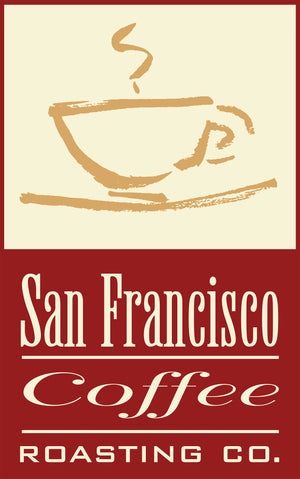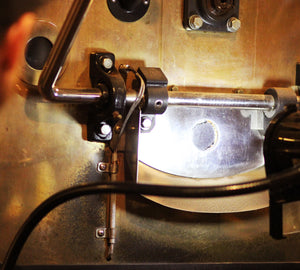If you've read our last post on the origin of coffee beans, you already know what a long journey coffee makes from the field to the cup. But beans are useless until they're roasted. The roasting process is the absolute key to producing insanely delicious coffee. And it's what San Fran goes for every time.
At our very first coffeehouse in Vinings, we placed a red-and-yellow Probat coffee roaster at the center of the shop, and it became a community hearth. Young kids and curious parents alike would circle the roaster, watching the barrel flip 26 pounds of coffee beans at a time. The smoke would rise through a chimney drenching the entire block with a tantalizing, fresh coffee scent. After about twenty years in use, we refurbished the veteran machine from the bottom up and sold her to a coffee fiend in Taiwan. (No matter where you go in the world, you'll find people who are as in love with coffee as we are).
But what exactly does it mean to roast coffee beans?
INTO THE ROASTER

When we receive beans at our coffeehouse, they're called green coffee beans. That is to say, coffee beans that have been cultivated and sun-dried, but have no flavor or drinkability. We pour these green beans into the barrel of the roasting machine—imagine a big cast-iron drum. Underneath, a fire starts heating the barrel, which rotates to evenly warm the beans.
Within the drum, there are blades and fins which rotate the coffee back-and-forth, from the front of the barrel to the back. In the first minutes, as the beans start to toast, we enter what many call the yellowing phase, though it's really the drying phase. This takes place at 329 degrees. At that temperature the roaster dries out any remaining moisture in the coffee, transforming it from green to an exquisite yellow color.
From there, we vary the roasting based on what kind of coffee we're trying to make. Think of it like an oven in your kitchen; depending on the temperature and bake time, you end up with a different result. But coffee roasting is an active process—at some point we might want to lower the temperature, or add more air, or reduce the oxygen. All of these variables result in a different batch, each with its own character.
MEDIUM ROAST
At around 385 degrees, the coffee beans attain a cinnamon color and are a little acidic in taste. At this point, the beans double in size, making a cracking noise as they expand. Hence, we call this milestone the first crack.
Typically we continue roasting past the first crack, but some of our coffee world peers have experimented with slightly under-roasted beans of this temperature. The result is a tart, slightly acidic brew.
At San Francisco Coffee, we like to offer a medium roast that cooks between 400 and 410 degrees. By that temperature, the coffee is full of flavor, with a bright, shiny verve, and a slightly muted acidity. It's the perfect roast for beans from Guatemala or Costa Rica.
FULL CITY ROAST
As lovely as our medium roast is, some beans deserve a little more firing before they reach their potential. Around 435 degrees, we produce what we call our Full City Roast.
Legend has it that back in the early days of coffee culture, Seattle roasters loved their coffee very dark, while LA drinkers preferred a mellow medium roast. Midway in San Francisco, roasters created what they called the Full City, a middle-ground between the two.
At SF, our Full City has a slight sweetness and a respectable body.
DARK ROAST
By 445 degrees, our beans are dark, with a bittersweet caramel flavor and perfect acidity. At this temperature, the barrel is full of smoke, which clings to the beans. That makes a dark roast perfect if you enjoy a smoky flavor with your coffee.
Our Atlanta crowd tends to love dark roasts, which is why we offer 12 varieties of the stuff. Dark roasting is ideal when the beans come from a variety of sources. It is also the roast we use for our signature cold brew.
Of course, tastes have changed in the thirty years since we first started sharing our coffee with Atlanta. These days, many of our younger drinkers prefer the medium roasts to the dark, robust variety.
DRINK UP
Once the roasting is complete, we drop the beans onto a cooling tray. Underneath, a fan starts to turn, lowering the temperature of the beans so that they stop roasting immediately. From there, we let the beans breathe for about an hour before bagging them. Alternatively, if we want to use the beans for making cold brew, we'll let them breathe overnight, about eight or nine hours, before proceeding.
As you can see, the process is an artful craft, with all sorts of variables we can play with. Over three decades, we've experimented many ways, which is why our customers can always count on us to bring something new and exciting.
So what's the best roast, you may ask? There's really no right, wrong, best or worst. When roasted properly, all coffee can be delicious in its own unique way.
-Doug


